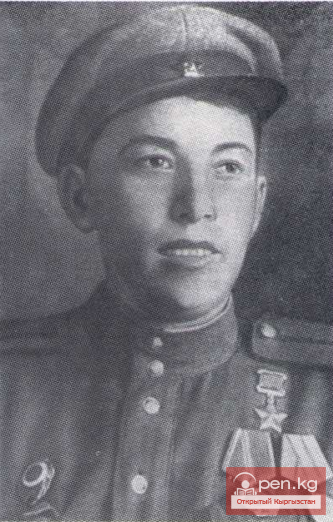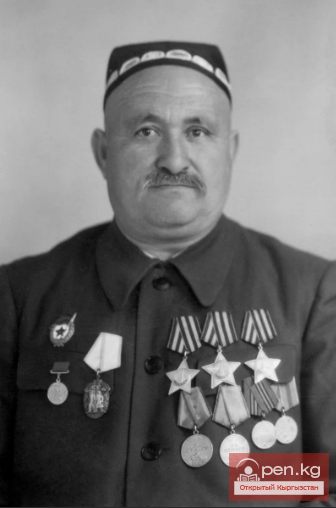
Hero of the Soviet Union Tsindelis Berelis Israelievich
Berelis Israelievich Tsindelis was born in 1916 in the city of Rokiškis, Lithuanian SSR, in the family of a civil servant. Jewish. From 1937 to 1941, he worked as a dental technician in the cities of Panevėžys and Biržai. He was drafted into the Soviet Army in June 1942 from the city of Osh, Kyrgyz SSR. Private. Gunner.
During the Great Patriotic War, he fought as part of the Central and 1st Baltic Fronts. He participated in battles near Oryol, in the liberation of Belarus and Lithuania. In 1943, he was awarded the medal "For Courage".
He distinguished himself in battles on Lithuanian soil. On October 13, 1944, in a clash with enemy tanks, he showed heroism and courage. On March 24, 1945, Tsindelis Berelis Israelievich was posthumously awarded the title of Hero of the Soviet Union.
He was buried in a military cemetery in the city of Pagėgiai, Lithuanian SSR. Streets in the cities of Rokiškis and Pagėgiai are named after him. His name is carried by several pioneer detachments.
IN A CLASH WITH TANKS
Young scouts... How many legendary names and unparalleled feats have they revived for humanity and the grateful memory of the relatives and friends of the fallen! Their persistent and tireless searches deserve the highest praise and recognition...

Here is a letter received from the young scouts of the Palace of Pioneers in the city of Vilnius, which provides sparse but vivid information about Hero of the Soviet Union Tsindelis Berelis Israelievich, drafted into the ranks of the Red Army by the Osh city military enlistment office of the Kyrgyz SSR in June 1942:
“Tsindelis Berelis Israelievich.
From 1937 to 1941, he worked as a dental technician in the cities of Panevėžys and Biržai.
From 1942 to 1944 — a soldier of the 16th Lithuanian Rifle Division. He participated in battles near the city of Oryol, at the Kursk Bulge, and liberated Belarus and Lithuania.
He was buried in a military cemetery in the city of Pagėgiai, Lithuanian SSR.
The entire family perished during the war; there are no living relatives.
Streets in the cities of Rokiškis and Pagėgiai are named after Tsindelis. His name is carried by pioneer squads of Pagėgiai, Šilalė, and Rokiškis secondary schools.”
...The invasion of Hitler's hordes into our country, into his native, very young Soviet Lithuania. A land tortured and soaked in blood. The atrocities and violence of the occupiers against defenseless people, the death of relatives and friends.
The difficult evacuation from the homeland... All this gave rise to an indelible hatred for the enemy in Berelis's heart, filled with bitterness and resentment.
Ancient Osh seemed to stretch out at the very edge of the earth, bathed in the rays of dazzling sunshine.
The local residents treated the families of the evacuees with care and compassion. Yet, much here seemed unfamiliar and strange to the native Baltic person in the first days. The incessant rustling of tall white-stemmed poplars, the narrow streets with clay fences, and the quiet murmuring of clear ditches... But Berelis soon fell in love with this land. It rightfully bears the name of the pearl of the Fergana Valley.
And in the heart of the young doctor, day by day, grew an insatiable, all-consuming hatred for the enemy, who was tearing towards Moscow and holding the wounded and starving Leningrad in the iron grip of the blockade. And still, his native Lithuania groaned under the iron boot of the occupiers. No, he must become a soldier and crush the enemy with weapon in hand!
He saw and felt with all his heart the incredible hardships of wartime that fell upon the people of this city, so far from the front, but participating as actively as the entire deep rear of the great country in bloody battles with the fascists. For the front and rear are inseparable.
And on the streets of Osh, more and more wounded appeared. A rest house was converted into an evacuation hospital. Tsindelis had to work day and night. And finally, the long-awaited summons came, sending him to the front.
The intense military training of a soldier who took up arms for the first time is hard to convey in words. It was exhausting, requiring complete dedication of all strength. But the hatred for the enemy was stronger than anything. And it gave Tsindelis new strength, helping him overcome difficulties and hardships.
From December 1942, he participated in fierce battles on the Central and later the Baltic fronts. As part of the 16th Lithuanian Division, he fought near Oryol and at the fiery Kursk Bulge. Beautiful stories and poems have been written about their fierce and bloody battles, which became historical, about the steadfastness and courage of our soldiers and officers.
In the fourth volume of "The History of the Great Patriotic War of the Soviet Union, 1941—1945," on page 197, there is information about the 16th Lithuanian Rifle Division, in which Tsindelis Berelis Israelievich fought:
“In the second half of August 1944, the enemy, seeking to seize the land communications connecting the 'North' group with East Prussia, to cut off the deeply entrenched troops of the 1st Baltic Front and to close the flanks of the 'North' and 'Center' army groups, struck our troops with strong blows: six tank and one motorized divisions and two tank brigades. The troops of the 1st Baltic Front skillfully maneuvered, repelled the enemy's attacks, and by the end of August 1944 had secured positions along the Memel River west of Jelgava — west and southwest of Dobele...

In the defensive battles in the Šiauliai area, the 2nd Guards Army distinguished itself. In its ranks, shoulder to shoulder with other units, stood the 16th Lithuanian Rifle Division under the command of Major General V. A. Karvėlis. This division, formed by a decree of the GKO by the summer of 1942, fought before arriving in its republic in battles near Oryol, at the Kursk Bulge, south of Nevel, and for Polotsk. On August 17, 1944, when the German-fascist troops broke through the defense of the Red Army units and rushed towards Šiauliai, the Lithuanian division was ordered to organize defense on the approaches to this important transport hub and prevent the Germans from entering the city. The soldiers of the division steadfastly repelled numerous attacks from superior enemy forces. With slogans like: “Not a step back!”, “No fascists in Šiauliai!” the communists inspired the fighters to heroism... Thanks to the mass heroism of the soldiers of the units and formations of the 1st Baltic Front, their steadfastness in defense, the task was accomplished. By the end of August 19, 1944, the Germans, leaving behind knocked-out tanks, self-propelled artillery, and many dead, retreated and ceased attempts to capture Šiauliai.
On October 31, 1944, the division was awarded the Order of the Red Banner, and later, for its participation in the liberation of the city and the seaport of Klaipėda, it received the title of "Klaipėda" ...
Gunner Tsindelis participated in the liberation of Belarus and his native Lithuania. On September 7, 1944, he was awarded the medal "For Courage". The award speaks for itself.
Onward and onward against the enemy was driven by the same unquenchable hatred for the invaders, who had taken from him, as from millions of Soviet people, everything most precious — mothers, wives, sisters, fathers, and brothers. In these battles, soldierly friendship grew stronger and tempered. In the Lithuanian division, there were fighters of different nationalities, and in the 224th artillery regiment, close friends affectionately called him — Borya...
He and his gun became one, inseparable by any forces or circumstances. It was a new, previously unknown alloy of man and steel, hatred and fire!
And to ensure that the gun became more formidable, accurate, and merciless in battle with each passing day, its gunner applied all his strength, skill, and dexterity to it.
He not only eagerly read but also recorded in his field notebook articles and instructions published in front-line and army newspapers. Here is a list of some publications: “Guns fire from ambush,” “Extending the ballistic life of the gun,” “Spotter Vitavsky,” “Lessons of ski marches,” “Bolshevik Valentin Kabin.” There was also persistent training at the front. The enemy had to be struck not only mercilessly but skillfully.
And the most fervent call for him, as for hundreds of thousands of fighters and officers, was at that time the call: “Let’s fight like Leningraders!”
And here is the last battle of Berelis Tsindelis and his heroic, immortal feat—on October 13, 1944, during the enemy's offensive on the village of Plai near 18 kilometers northwest of the city of Tilsit, Tsindelis's gun was positioned for direct fire on the front line of the 3rd company of the 167th rifle regiment. In the morning, the fascists launched an offensive.
Seven tanks and one self-propelled gun "Ferdinand" were moving towards the gun.
Letting the tanks get to 300-400 meters, the crew opened fire. The first shot disabled the "Ferdinand." The tanks concentrated fire on the gun. Tsindelis was seriously wounded by a fragment from a shell that exploded. The commander of the gun ordered him to leave the battlefield, but he, bleeding profusely, continued to fire and set another enemy tank on fire. The second shell killed all the crew members, including the brave gunner Tsindelis.

In the report of the commander of the 224th rifle regiment of the 16th Lithuanian rifle division, Lieutenant Colonel Simonaitis stated: “Red Army soldier Tsindelis is worthy of the title of Hero of the Soviet Union.”
Thus, in brief, is the combat path of Hero of the Soviet Union Berelis Israelievich Tsindelis, who gave his life for the freedom and independence of our Motherland.
Heroes do not die. They are immortal in the people's memory. Streets, schools, and pioneer detachments are named after them. Stories and poems are written about them, songs are composed.
A. Salnikov















































